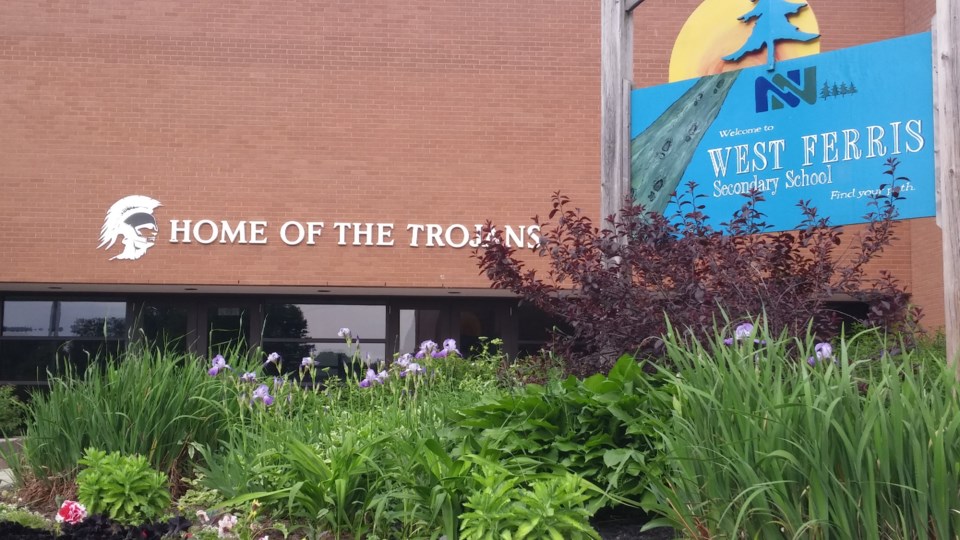After 20 public presentations at a special board meeting held Monday evening on the future of six schools in North Bay, chair of the board of trustees, David Thompson thanked those in attendance at West Ferris Intermediate Secondary School. "You've given us a lot to think about."
The nine school board trustees will announce their decision at a meeting June 27. Twenty presentations were given by parents, educators, and academics, many of them against the three-to-one school model. One line from the most recent Near North District School Board (NNDSB) staff report suggests that this decision is a sure thing: "While this [a three-to-two school decision] is a move in the right direction, staff have identified that this would be an interim solution for the North Bay Planning Area."
There was some support for going to a single combined intermediate and secondary school. Chippewa teacher and alumnus Bob Boal wondered whether refurbishing two schools was even feasible. "Is money available? How much?"
Boal made a plea for forward thinking in the decision of the trustees. "Education isn't the same as it once was. The objective has changed, the pedagogy has changed, and most importantly, students have changed. It is time we changed to be better able to reach them and help them move forward toward their life goals."
Intermediate Chippewa teacher Robyn Colvin advocated for students and teachers alike, stressing that a smooth transition was key, regardless of the board's decision. Colvin spoke highly of the integrated grades seven to 12 approach, saying, "I feel that our model has allowed me to grow considerably as a teacher, and more importantly, I feel that I make a tremendous difference in the lives of our students."
Parent Alissa Mitchell, who has three sons in the public school system, took a different spin, suggesting that a three-to-one school build at a site behind Memorial Gardens be examined. Mitchell told trustees that "there is a large group of silent parents out there who support the three-to-one option, but are weary of the ARC process."
Mitchell pointed to the benefits that a centrally located school would bring to the community, with amenities close by such as the YMCA and the hockey rink. Mitchell also gave the opinion that a build in Thomson Park (which could be relocated to the Chippewa school site) would alleviate the traffic concerns that many have raised about the O'Brien/High/Chippewa corridor. "Through the hockey season, those access points allow for up to 4,000 people to attend Battalion games, so getting half of that to and from school is doable."
Parent Kim Winrow, a mother of five, announced that this was the fourth time her family has been affected by the ARC process and would welcome a long-term solution such as a three-to-one model. "This decision must not be a Raiders versus Trojans versus Wildcats concern," she said, adding that going to two high schools would be a lateral move that would inevitably see the process start again to close one of the schools and go to one.
A group of parents, educators, and other community members rallied for the second time Monday to "Stop the Super School." The group made their presence felt during the Monday morning commute as they lined Lakeshore Drive, eliciting support from passersby. They assembled once more before the meeting Monday evening at West Ferris.
Kurt Clausen, an academic in the education field warned that the pillars of student achievement, curriculum, community, and efficiency used to justify larger schools, are better served in schools of 1,000 or fewer. "Despite massive consolidations of schools in the United States and Canada, there is little convincing evidence on how consolidation (past an optimum student number) actually benefits education districts in the long-run."
Robert Sampson, who rose to the position of superintendent during his career as an educator, has witnessed the super school model first-hand in southern Ontario. "The argument for creating smaller school environments is[...]a close relationship between student and teacher, and between student and the school environment[...]is found less frequently in larger schools."
Sampson added, "While the large argument for consolidating schools is largely economic, I would strongly suggest that these perceived economic gains be compared to the loss of student achievement and quality of learning in school classrooms."
Ever since the preferred option of the NNDSB staff to close West Ferris, Widdifield and Chippewa high schools and build a new school that would initially accommodate over 2,000 students from grades seven to 12 was announced, there has been a sizable public backlash on the subject.
In the most recent staff report from NNDSB, those objections were noted, and staff recommended the three-to-two schools option that was also backed by the ARC committee, albeit with language that would give leeway in deciding between the Widdifield and Chippewa sites as the second school refurbishment, in addition to the West Ferris site. All schools have been recommended to be renamed and rebranded regardless of the configuration.
The report also states clearly that the three-to-one school option is still very much on the table. The debate has moved beyond the fears of alumni losing their alma maters and history. All who presented legitimately that their preferred option is the best for our community.
Which will it be? Use our comments section to have your say.



